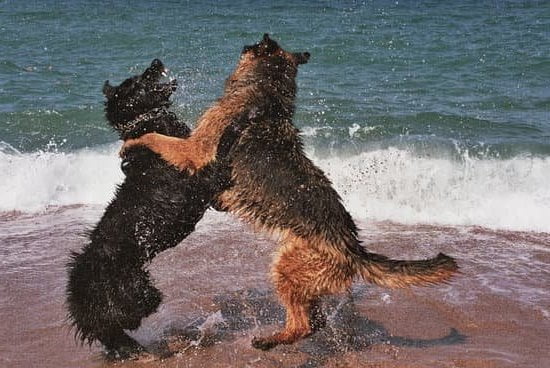Are you wondering when to train your dog for K9 training? It is important to understand the optimal timing for initiating K9 training to ensure the best outcomes for your canine companion.
K9 training plays a crucial role in law enforcement, search and rescue operations, and other specialized fields, requiring dogs to possess specific skills and behaviors. In this article, we will delve into the key considerations for training your dog for K9 roles, including age factors, basic training foundations, signs of readiness, breed-specific considerations, and valuable training resources and tips.
K9 training encompasses the specialized instruction of dogs for a variety of roles such as tracking suspects, detecting illegal substances, and providing support in disaster situations. The success of these tasks relies heavily on the proper training and development of K9 dogs. Therefore, understanding when to start this training process is essential to ensure that the dog is adequately prepared both mentally and physically.
While starting at an ideal age is important, it’s equally crucial to establish a strong foundation in basic obedience before advancing to specialized skills. Additionally, each dog may exhibit unique behaviors that indicate their readiness for K9 training. By having a thorough understanding of these factors and resources available for effective K9 training, dog owners can set their pets up for success in their future roles as highly skilled working dogs.
Understanding K9 Training
Roles of K9 Dogs
K9 training encompasses a diverse range of skills and roles that dogs can fulfill in various professional fields. These can include law enforcement, search and rescue, detection of narcotics or explosives, and even therapy work. In law enforcement, K9 officers are trained to track suspects, detect drugs or explosives, and provide support during apprehensions.
Search and rescue dogs are trained to locate missing persons in different terrains and conditions. Understanding the versatility of K9 training allows dog owners to appreciate the value that their pets can bring to these critical roles.
Importance of Proper Training
Proper K9 training is essential for the safety and effectiveness of both the dog and their handlers. Without the necessary training, a K9 dog may not be able to perform its duties adequately, potentially putting lives at risk.
Additionally, well-trained dogs are less likely to exhibit aggressive or unpredictable behavior, ensuring that they can work confidently in a variety of situations without posing a threat to others. Understanding the critical nature of K9 training underscores the significance of determining when to train a dog for this purpose.
Ethical Considerations
K9 training also involves ethical considerations regarding how dogs are trained and utilized in different professions. It is important for trainers and handlers to prioritize the health and well-being of these animals as they undergo rigorous training regimens. By understanding the principles of ethical treatment in K9 training, dog owners can ensure that their pets receive appropriate care as they prepare for their roles in various fields of service.
Age Considerations for Training
When to train a dog for K9 training is a crucial consideration for any potential handler or owner. The optimal age range for starting K9 training is typically between 12-18 months.
This age range allows the dog to have developed both physically and mentally, as K9 training requires dogs to be in top physical condition and possess the mental maturity necessary to handle the rigors of training. Additionally, at this age, dogs are also more receptive to learning and bonding with their handlers.
It is important not to start K9 training too early, as young dogs may not have fully developed muscles and bones, making them susceptible to injuries from the physical demands of K9 work. On the other hand, waiting too long to begin training can result in missed opportunities for the dog’s prime learning window.
It’s essential for dog owners and trainers to pay attention to the individual dog and their unique development timeline, rather than adhering strictly to a specific age range.
At around 12-18 months of age, dogs are usually in their adolescent phase when they have high energy levels and an eagerness to please, which can be channeled into productive training. This period is also ideal for building a strong bond between the dog and its handler, leading to better communication and trust during training sessions.
However, it is important to keep in mind that these are general guidelines and that each individual dog should be assessed on its own readiness for K9 training.
| Optimal Age Range | 12-18 Months |
|---|---|
| Developmental Considerations | Physical & Mental readiness |
| Risks of Training Too Early | Injury from undeveloped muscles & bones |
| Risks of Waiting Too Long | Missed opportunities during prime learning window |
Basic Training Foundations
Before diving into advanced K9 training, it is crucial to establish a strong foundation of basic training for your dog. This foundation serves as the building blocks for more specialized skills and commands. Basic training focuses on teaching your dog essential commands like sit, stay, come, and heel. These commands lay the groundwork for obedience and control, which are essential for any K9 training program.
In addition to commands, basic training also includes leash manners, crate training, and socialization. Dogs need to learn how to behave appropriately on a leash, as well as understand the concept of boundaries and personal space through crate training. Socialization with other dogs and people is also a key component of basic training, as it helps your dog develop good behavior around others.
When considering when to train your dog for K9 training, remember that starting with a solid foundation in basic training is essential. Without these fundamental skills in place, it will be much more challenging to progress to more advanced K9 training techniques. Therefore, take the time to focus on basic obedience and control before moving on to specialized skills and commands. This will set both you and your dog up for success in the long run.
Signs of Readiness
When considering K9 training for your dog, it is important to recognize the signs of readiness that indicate whether your furry friend is prepared for this specialized training. Identifying these behaviors and characteristics can help ensure a successful and positive training experience for both you and your canine companion.
Here are some signs of readiness to look out for when determining if your dog is ready for K9 training:
- Obedience: A well-behaved and obedient dog is essential for K9 training. If your dog responds well to basic commands such as sit, stay, and come, it may be a good indication that they are ready to progress to more advanced training.
- Socialization: Canine socialization with other dogs and humans is crucial for K9 dogs, especially those involved in law enforcement or search and rescue. Dogs who are friendly, confident, and comfortable interacting with others are more likely to succeed in these roles.
- Focus: An ability to focus on tasks and follow instructions is an important trait for K9 dogs. If your dog can maintain concentration during training sessions and shows a willingness to learn new skills, they may be ready to start K9 training.
It is important to observe these signs of readiness in your dog before embarking on K9 training. Being attuned to your dog’s behavior and temperament will help you make an informed decision about the right time to start their training journey.
Training Timeline
When to train a dog for K9 training is a crucial consideration for successful K9 training. The timing of when to start the training process can significantly impact the effectiveness and overall success of the training. For most dogs, the optimal age to begin K9 training is between 12 to 18 months old. This age range ensures that the dog has reached physical and mental maturity, allowing them to handle the rigorous demands of K9 training effectively.
At around 12 months, most dogs have completed their basic obedience and socialization foundation, making them ready for more specialized K9 training. By this age, dogs have also developed better focus and attention span, which are essential for learning complex commands and skills required in K9 training.
It’s important to note that while starting at 12-18 months is generally recommended, some breeds may mature sooner or later. It’s essential to consider the individual characteristics and development of each dog before beginning their K9 training journey. Additionally, factors such as previous training or behavioral issues may also influence the timing of when to start K9 training for a particular dog.
| Age Range | Training Considerations |
|---|---|
| 12-18 months old | Physical and mental maturity, completed basic obedience foundation |
| Breed-specific differences | Some breeds may mature sooner or later than others |
| Individual characteristics | Consider each dog’s unique development and previous training experiences |
Overall, understanding the optimal age for when to train a dog for K9 training is critical in ensuring that the dog is fully prepared for the challenges that come with specialized work in law enforcement or search and rescue. Starting at the right time sets the stage for a smooth and successful transition into advanced K9 training.
Breed-Specific Considerations
Training Timelines for Different Breeds
When considering when to train a dog for K9 training, it’s important to take into account the breed-specific considerations that can affect the timing and methods of training. Different dog breeds have varying levels of physical and mental maturity, as well as natural instincts and behaviors that can impact their readiness for K9 training.
For example, breeds like German Shepherds and Belgian Malinois are commonly used in law enforcement K9 units due to their intelligence, strength, and agility. These breeds may be ready for more advanced training at an earlier age compared to other breeds.
On the other hand, smaller breeds or those with more sensitive temperaments may require a longer basic obedience training period before advancing to specialized K9 skills. It’s essential for dog owners to research their specific breed’s typical development timeline and consult with experienced trainers or veterinarians to determine the best approach for their dog.
Adapting Training Methods
In addition to timing, breed-specific considerations also extend to the adaptation of training methods. Certain breeds may respond better to reward-based training, while others might require a firmer hand and consistent discipline. Understanding the natural tendencies and characteristics of different breeds is crucial in tailoring an effective K9 training program that brings out the best in each individual dog.
For example, breeds with high prey drives may need extra focus on impulse control and redirection techniques during their training. On the other hand, breeds known for their loyal and protective nature may benefit from specialized socialization exercises to ensure they can work effectively alongside handlers and within various environments.
Seeking Breed-Specific Expertise
Dog owners embarking on K9 training should seek out trainers who have experience working with their specific breed. A trainer who understands the breed-specific considerations will be better equipped to create a successful training plan tailored to the dog’s needs. Additionally, connecting with other owners of similar breeds who have gone through K9 training can provide invaluable insights and support throughout the process.
By recognizing the unique qualities of different dog breeds and adjusting training approaches accordingly, dog owners can set their pets up for success in K9 roles that align with their natural abilities and instincts.
Training Resources and Tips
When deciding when to train a dog for K9 training, it is important to consider various resources and tips that can help guide the process. Professional trainers can provide valuable expertise and experience in K9 training, offering insights into the specific needs and abilities of different dog breeds. Additionally, enrolling in training programs can provide structured learning experiences for both dogs and their handlers, covering essential techniques and commands necessary for K9 work.
One of the key tips for effective K9 training is consistency. Dogs thrive on routine and repetition, so establishing a consistent training schedule and method can greatly contribute to successful training outcomes. It’s also important to create a positive learning environment by using rewards and positive reinforcement to encourage desired behaviors. This not only motivates the dog but also strengthens the bond between the dog and handler.
Furthermore, utilizing additional resources such as online tutorials, books, and educational materials can supplement formal training programs. These resources offer a wealth of information on various aspects of K9 training, from basic obedience to specialized skills required for specific roles such as search and rescue or narcotics detection. By combining professional guidance with individual learning opportunities, dog owners can enhance their understanding of K9 training and support their dogs’ development effectively.
Conclusion
In conclusion, knowing when to train a dog for K9 training is crucial for the success of both the training process and the dog’s future performance. As discussed in this article, the optimal age range for starting K9 training is typically between 12-18 months, when a dog has reached physical and mental maturity. This ensures that the dog is better equipped to handle the rigors of advanced training and can fully develop their potential as a K9 partner.
It is important to recognize the signs of readiness in a dog, such as socialization, obedience, and focus, before embarking on K9 training. Establishing basic training foundations and commands beforehand also sets a strong framework for more specialized skills later on. Additionally, taking into account breed-specific considerations can help tailor the training process to each individual dog’s natural abilities and tendencies.
For those interested in pursuing K9 training for their dogs, seeking out professional trainers and reputable training programs is essential. The guidance and expertise of experienced trainers can make all the difference in preparing a dog for roles in law enforcement, search and rescue operations, or other fields where K9s play a vital role. With careful preparation and dedication to the process, owners can maximize their dog’s potential as a valuable K9 partner.
Frequently Asked Questions
What Age Do K9 Dogs Start Training?
K9 dogs typically start their training at around 12-18 months of age. This allows them to develop both physically and mentally before the rigorous training begins.
At What Age Is Dog Training Most Effective?
Dog training is most effective when started at a young age, ideally as early as 7-8 weeks old. Puppies are like sponges, soaking up information easily and adapting quickly to new experiences.
Can You Train a Dog to Be a K9?
Yes, it is possible to train a dog to become a K9. It requires dedication, time, and specialized training techniques to ensure that the dog has the necessary skills and temperament for police or military work.

Welcome to the blog! I am a professional dog trainer and have been working with dogs for many years. In this blog, I will be discussing various topics related to dog training, including tips, tricks, and advice. I hope you find this information helpful and informative. Thanks for reading!





